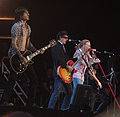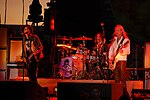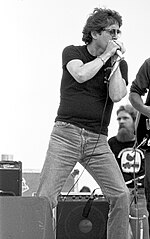Portal:Rock music
The Rock Music Portal
Rock is a broad genre of popular music that originated as "rock and roll" in the United States in the late 1940s and early 1950s, developing into a range of different styles from the mid-1960s, particularly in the United States and the United Kingdom. It has its roots in rock and roll, a style that drew directly from the genres of blues, rhythm and blues, and country music. Rock also drew strongly from genres such as electric blues and folk, and incorporated influences from jazz and other musical styles. For instrumentation, rock is typically centered on the electric guitar, usually as part of a rock group with electric bass guitar, drums, and one or more singers. Usually, rock is song-based music with a 4
4 time signature and utilizing a verse–chorus form, but the genre has become extremely diverse. Like pop music, lyrics often stress romantic love but also address a wide variety of other themes that are frequently social or political. Rock was the most popular genre of music in the U.S. and much of the Western world from the 1950s to the 2010s.
Rock musicians in the mid-1960s began to advance the album ahead of the single as the dominant form of recorded music expression and consumption, with the Beatles at the forefront of this development. Their contributions lent the genre a cultural legitimacy in the mainstream and initiated a rock-informed album era in the music industry for the next several decades. By the late 1960s "classic rock" period, a few distinct rock music subgenres had emerged, including hybrids like blues rock, folk rock, country rock, Southern rock, raga rock, and jazz rock, which contributed to the development of psychedelic rock, influenced by the countercultural psychedelic and hippie scene. New genres that emerged included progressive rock, which extended artistic elements, heavy metal, which emphasized an aggressive thick sound, and glam rock, which highlighted showmanship and visual style. In the second half of the 1970s, punk rock reacted by producing stripped-down, energetic social and political critiques. Punk was an influence in the 1980s on new wave, post-punk and eventually alternative rock.
From the 1990s, alternative rock began to dominate rock music and break into the mainstream in the form of grunge, Britpop, and indie rock. Further fusion subgenres have since emerged, including pop-punk, electronic rock, rap rock, and rap metal. Some movements were conscious attempts to revisit rock's history, including the garage rock/post-punk revival in the 2000s. Since the 2010s, rock has lost its position as the pre-eminent popular music genre in world culture, but remains commercially successful. The increased influence of hip-hop and electronic dance music can be seen in rock music, notably in the techno-pop scene of the early 2010s and the pop-punk-hip-hop revival of the 2020s. (Full article...)
General images -
Selected article
Alice in Chains rose to international fame as part of the grunge movement of the early 1990s, along with other Seattle bands such as Nirvana, Pearl Jam, and Soundgarden. They achieved success during the era with the albums Facelift (1990), Dirt (1992) and Alice in Chains (1995), as well as the extended play Jar of Flies (1994). The band was plagued by extended inactivity from 1996 onward, largely due to Staley's substance abuse, which resulted in his death in 2002 and caused the band to go on hiatus. Alice in Chains regrouped in 2005, with DuVall joining in 2006 as rhythm guitarist and sharing lead vocal duties; the band has since released three more albums: Black Gives Way to Blue (2009), The Devil Put Dinosaurs Here (2013) and Rainier Fog (2018).
Since its formation, Alice in Chains has released six studio albums, three EPs, three live albums, four compilations, two DVDs, 43 music videos and 32 singles. The band has sold more than 30 million records worldwide, and over 20 million records in the US alone. The band has had 18 Top 10 songs on Billboard's Mainstream Rock Tracks chart and 5 No. 1 hits, and has received eleven Grammy Award nominations. The band was ranked number 34 on VH1's 100 Greatest Artists of Hard Rock and as the 15th greatest live band by Hit Parader. (Full article...)
Selected biography
In 1963, he formed the Paul Butterfield Blues Band, which recorded several successful albums and was popular on the late-1960s concert and festival circuit, with performances at the Fillmore West in San Francisco, the Fillmore East in New York City, the Monterey Pop Festival, and Woodstock. The band was known for combining electric Chicago blues with a rock urgency. and for their pioneering jazz fusion performances and recordings. The band was also among the first racially integrated blues groups. After the breakup of the group in 1971, Butterfield continued to tour and record with the band Paul Butterfield's Better Days, with his mentor Muddy Waters, and with members of the roots-rock group the Band. While still recording and performing, Butterfield died in 1987 at age 44 of an accidental drug overdose.
Music critics have acknowledged his development of an original approach that places him among the best-known blues harp players. In 2006, he was inducted into the Blues Hall of Fame. Butterfield and the early members of the Paul Butterfield Blues Band were inducted into the Rock and Roll Hall of Fame in 2015. Both panels noted his harmonica skills and his contributions to bringing blues music to a younger and broader audience. (Full article...)
Selected album
Highway 61 Revisited is the sixth studio album by the American singer-songwriter Bob Dylan, released on August 30, 1965, by Columbia Records. Dylan continued the musical approach of his previous album Bringing It All Back Home (1965), using rock musicians as his backing band on every track of the album in a further departure from his primarily acoustic folk sound, except for the closing track, the 11-minute ballad "Desolation Row". Critics have focused on the innovative way Dylan combined driving, blues-based music with the subtlety of poetry to create songs that captured the political and cultural climate of contemporary America. Author Michael Gray argued that, in an important sense, the 1960s "started" with this album.
Preceded by the hit single "Like a Rolling Stone", the album features songs that Dylan has continued to perform live over his long career, including "Ballad of a Thin Man" and the title track. He named the album after the major American highway which connected his birthplace of Duluth, Minnesota, to southern cities famed for their musical heritage, including St. Louis, Memphis, New Orleans, and the Delta blues area of Mississippi.
Highway 61 Revisited peaked at No. 3 on the US Billboard Top LPs chart and No. 4 on the UK Albums Chart. Positively received on release, the album has since been described as one of Dylan's best works and among the greatest albums of all time, ranking No. 4 on Rolling Stone's "The 500 Greatest Albums of All Time list in 2003 and repositioned to No. 18 in the 2020 revision. It was voted No. 26 in the third edition of Colin Larkin's All Time Top 1000 Albums (2000) and was featured in Robert Dimery's 1001 Albums You Must Hear Before You Die (2010). "Like a Rolling Stone" was a top-10 hit in several countries, and was listed at No. 4 on Rolling Stones "The 500 Greatest Songs of All Time" list in 2021. Two other songs, "Desolation Row" and "Highway 61 Revisited", were listed at No. 187 and No. 373 respectively on the 2010 list. ('Full article...)
Selected song
"Like a Rolling Stone" is a song by the American singer-songwriter Bob Dylan, released on July 20, 1965, by Columbia Records. Its confrontational lyrics originated in an extended piece of verse Dylan wrote in June 1965, when he returned exhausted from a grueling tour of England. Dylan distilled this draft into four verses and a chorus. "Like a Rolling Stone" was recorded a few weeks later as part of the sessions for the forthcoming album Highway 61 Revisited as its opening track.
During a difficult two-day preproduction, Dylan struggled to find the essence of the song, which was demoed without success in 3
4 time. A breakthrough was made when it was tried in a rock music format, and rookie session musician Al Kooper improvised the Hammond B2 organ riff for which the track is known. Columbia Records was unhappy with both the song's length at over six minutes and its heavy electric sound, and was hesitant to release it. It was only when, a month later, a copy was leaked to a new popular music club and heard by influential DJs that the song was put out as a single. Although radio stations were reluctant to play such a long track, "Like a Rolling Stone" reached No. 2 in the US Billboard charts (No. 1 in Cashbox) and became a worldwide hit.
Critics have described "Like a Rolling Stone" as revolutionary in its combination of musical elements, the youthful, cynical sound of Dylan's voice, and the directness of the question "How does it feel?" It completed the transformation of Dylan's image from folk singer to rock star, and is considered one of the most influential compositions in postwar popular music. Rolling Stone magazine listed it at No. 1 on their 2004 and 2010 "500 Greatest Songs of All Time" lists. It has been covered by many artists, from the Jimi Hendrix Experience and the Rolling Stones to the Wailers, Cat Power, Titus Andronicus and Green Day. At an auction in 2014, Dylan's handwritten lyrics to the song fetched $2 million, a world record for a popular music manuscript. (Full article...)
Selected picture

Joan Baez and Bob Dylan at a civil rights march on Washington, D.C., 28 August 1963.
Did you know (auto-generated)

- ... that when rock musician Warren Zevon received a terminal diagnosis of lung cancer, he learned to "enjoy every sandwich"?
- ... that Rolling Stone listed Ácido Argentino as the most essential album of Argentine heavy metal?
- ... that Skálmöld & Sinfóníuhljómsveit Íslands documents a symphony orchestra playing heavy metal music?
- ... that Desulfovibrio vulgaris can remove toxic heavy metals from the environment?
- ... that the British rock musician Hannah Grae went viral online with an anti-sexual harassment parody of Aqua's "Barbie Girl"?
- ... that heavy metal band Judas Priest took their name from Bob Dylan's song "The Ballad of Frankie Lee and Judas Priest"?
Selected genre
Garage rock (sometimes called garage punk or '60s punk) is a raw and energetic style of rock music that flourished in the mid-1960s, most notably in the United States and Canada, and has experienced a series of subsequent revivals. The style is characterized by basic chord structures played on electric guitars and other instruments, sometimes distorted through a fuzzbox, as well as often unsophisticated and occasionally aggressive lyrics and delivery. Its name derives from the perception that groups were often made up of young amateurs who rehearsed in the family garage, although many were professional. (Full article...)
Selected audio
Related portals
WikiProjects
Things you can do
Expand: College rock, Electronic rock, Pop rock
Clean Up: Instrumental rock, Rap rock, New wave, Industrial rock, Progressive metal, Southern rock, Folk rock, Funk rock, Space rock
Add Sources: Pagan rock
Join one of the many WikiProjects pertaining to Rock music.
News
No recent news
More articles -
"Free as a Bird" is a single released in December 1995 by English rock band the Beatles. The song was originally written and recorded in 1977 as a home demo by John Lennon. In 1995, 25 years after their break-up and 15 years after Lennon's murder, his then surviving bandmates Paul McCartney, George Harrison and Ringo Starr released a studio version incorporating the demo.
The single was released as part of the promotion for The Beatles Anthology video documentary and the Anthology 1 compilation album. For the Anthology project, McCartney asked Lennon's widow Yoko Ono for unreleased material by Lennon to which the three remaining ex-Beatles could contribute. "Free as a Bird" was one of three such songs (along with "Real Love" and, decades later, "Now and Then") for which McCartney, Harrison, and Starr contributed additional instrumentation, vocals, and arrangements. Jeff Lynne, who had worked with Harrison on Harrison's album Cloud Nine and as part of the Traveling Wilburys, co-produced. (Full article...)
More did you know...
- ... that David Bowie's first gig as lead singer was at the Green Man, Blackheath?
- ... that Carlton le Willows Academy alumni include cricketer Mark Footitt, Air Supply singer/guitarist Graham Russell, and balloonist Janet Folkes?
- ... that the video for Marilyn Manson's soft-rock ballad "Running to the Edge of the World" was widely condemned for its depiction of violence against women?
- ... that Susan Beschta was a punk rocker and federal judge?

- ... that the FM Non-Duplication Rule adopted by the FCC 60 years ago led to the creation of the album-oriented and classic rock radio formats?
- ... that The Elvis Dead, a retelling of Evil Dead II in the style of Elvis Presley, features songs such as "Standing in a State of Shock", "I've Been Possessed", and "Wrapped Up in Vines"?
Major topics
Subcategories
Associated Wikimedia
The following Wikimedia Foundation sister projects provide more on this subject:
-
Commons
Free media repository -
Wikibooks
Free textbooks and manuals -
Wikidata
Free knowledge base -
Wikinews
Free-content news -
Wikiquote
Collection of quotations -
Wikisource
Free-content library -
Wikiversity
Free learning tools -
Wikivoyage
Free travel guide -
Wiktionary
Dictionary and thesaurus














































